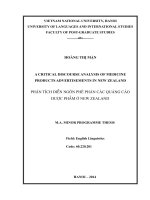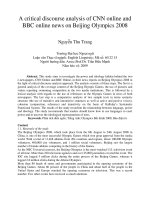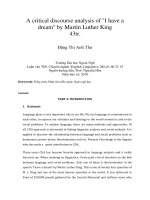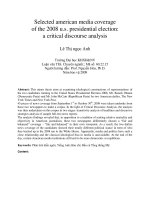Selected american media coverage of the 2008 US presidential election a critical discourse analysis
Bạn đang xem bản rút gọn của tài liệu. Xem và tải ngay bản đầy đủ của tài liệu tại đây (264.72 KB, 10 trang )
Selected american media coverage
of the 2008 u.s. presidential election:
a critical discourse analysis
Lê Thị ngọc Anh
Trường Đại học KHXH&NV
Luận văn ThS. Chuyên ngành:; Mã số: 60.22.15
Người hướng dẫn: Prof. Nguyễn Hòa, Ph D.
Năm bảo vệ:2009
Abstract: This minor thesis aims at examining ideological constructions of representations of
the two candidates running in the United States Presidential Election 2008, Mr. Barack Obama
(Democratic Party) and Mr. John McCain (Republican Party) by two American dailies, The New
York Times and New York Post.
45 pieces of news coverage from September 1
st
to October 30
th
, 2008 were taken randomly from
these two newspapers to make a corpus. In the light of Critical Discourse Analysis, the analysis
was then undertaken on this corpus in two stages: transitivity analysis of headlines and discursive
strategies analysis of sample full-text news reports.
The analysis findings revealed that, in opposition to a tradition of seeking relative neutrality and
objectivity in American journalism, these two newspapers deliberately chosen a “fair and
balanced” coverage – “fair and balanced” in their own viewpoint. As a result, the two dailies
news coverage of the candidates showed their totally different political stance in term of who
they backed up in the 2008 run to the White House. Apparently, media and politics have such a
close relationship and the classical ideological bias in media is unavoidable. At the end of the
day, certain American media institutions still tend to be more democratic or republican.
Keywords: Phân tích diễn ngôn; Tiếng Anh; Báo chí; Bầu cử Tổng thống Mỹ.
Content:
TABLE OF CONTENTS
DECLARATION i
ACKNOWLEDGEMENT ii
ABSTRACT iii
ABBREVIATIONS iv
LIST OF TABLES v
LIST OF APPENDICES vi
PART 1: INTRODUCTION
1. Rationale 1
2. Scope of the research 2
3. Aims of the research and research questions 2
4. Methodology of the research 3
5. Background information about the 2008 U.S. Presidential Election 3
6. Design of the research 5
PART 2: DEVELOPMENT
CHAPTER 1: THEORETICAL BACKGROUND 6
1.1. What is Critical Discourse Analysis (CDA)? 6
1.2. The development of CDA 6
1.3. Directions in CDA 7
1.3.1. Van Dijk 7
1.3.2. Wodak 9
1.3.3. Fairclough 10
1.4. Principles of CDA 10
CHAPTER 2: METHODOLOGY 12
2.1. Data 12
2.1.1. Data source 12
2.1.1.1. The New York Times 12
2.1.1.2. New York Post 12
2.1.2. Data collection and sampling 13
2.2. Analytical framework and methods 13
2.2.1. Headlines analysis 13
2.2.2. Full-text news report analysis 15
CHAPTER 3: DATA ANALYSIS AND DISCUSSION 16
3.1. Headlines analysis 16
3.1.1. The New York Times 17
3.1.1.1. Representation of Mr. Obama 17
3.1.1.2. Representation of Mr. McCain 20
3.1.2. New York post 22
3.1.2.1. Representation of Mr. Obama 23
3.1.2.2. Representation of Mr. McCain 25
3.2. Full-text stories analysis 26
3.2.1. Naming referent 26
3.2.1.1. The New York Times 26
3.2.1.2. New York Post 27
3.2.2. Lexicalization 29
3.2.2.1. The New York Times 29
3.2.2.2. New York Post 33
PART 3: CONCLUSION
1. Summary of major findings 36
2. Suggestions for further research 36
REFERENCES
APPENDICES
1
Part 1: INTRODUCTION
1. Rationale
Everyday we use language, in other words - produce discourse, to negotiate, to give
information, to ask for information or to make choices; in short, to communicate. To
discourse analysts, “discourse” means actual instances of communication in the medium of
language. In the discourse we produce are conventional ways of talking that create and
perpetuate systems of ideologies and sets of beliefs about how the world works. Van Dijk
(1988) points out that discourse, in a wider sense, is a complex unit of language form,
meaning and actions that might best be captured under the notion of a communicative
event or communicative act.
Among many types of discourse produced under different contexts/communicative events,
journalistic discourse has some very specific textual characteristics, specific methods of
text production and consumption, and is defined by a particular set of relationships
between itself and other agencies of symbolic and material power. As Fowler (1991)
pointed out, the language of the news is never neutral, and articles within newspaper must
be regarded as constructed “stories” told from particular point of view. When it comes to
journalistic discourse analysis, the Critical Discourse Analysis (CDA) approach is often
employed. CDA is a methodology that enables a vigorous assessment of what is meant
when language is used to describe and explain.
How the media describe and explain things or events and portray people can have a great
influence on the public who often have decisions and choices to make. That explains why
the role of the media in electoral politics is key to the functioning of a democracy, because
now most voters increasingly use the media as their primary source of information.
All the information about discourse and media briefly mentioned above leads the author of
this thesis to the research topic and conduct a small study entitled “Selected American
Media Coverage of the 2008 U.S. Presidential Election: A Critical Discourse Analysis”.
2
2. Scope of the research
Within the limit of a minor thesis, this research focus only on the texts of the news reports
published from 31
st
August 2008 to 1
st
November 2008 in the two dailies The New York
Times and New York Post, on the topic of the 2008 U.S Presidential Election. In this
research, 45 headlines and 24 full-text news reports are analyzed. As this is a purely
linguistic study, the author is not, by any means or in any way, expressing her own
political point of view.
3. Aims of the research and research questions
The general goal of this research is to investigate the ideological function of language in
representing the world and constructing certain realities. The main objective is to look into
the ways language be employed by two media institutions to produce discourse to present
the two 2008 U.S. presidential candidates. More specifically, this thesis aims at:
- Providing a textual analysis of the news on the 2008 U.S. presidential election in the light
of Critical Discourse Analysis.
- Giving an illustration of the CDA concepts as well as analysis procedures.
- Conveying a message that CDA provides a useful, systematic way for language users and
language learners to begin raising awareness of the ideologies embedded in discourse, as
language not only reflects and records but also shapes, distorts and even create realities,
both culturally and naturally.
To achieve these aims, the following research questions are proposed:
(i) What are the representations of the two 2008 presidential candidates, the
Republican John McCain and the Democrat Barack Obama, constructed by The
New York Times and the New York Post?
(ii) What are the underlying ideologies embedded in the way The New York Times
and New York Post represent the two candidates?
(iii) How are such ideologies encoded in the discourse of the two newspapers?
3
4. Methodology of the research
Following in this part is a brief summary of the basic steps taken in the research.
The first step is to conduct a literature review. The author searched for reference via the
thesis advisor, Dr. Nguyen Hoa, lectures of related subjects like Research Methods,
Applied Linguistics, etc., books and journals in the libraries and materials from the
Internet.
The second step is searching for data. News reports published from 31
st
August 2008 to 1
st
November 2008 in the two selected newspapers were collected. Then the data for analysis
were sampled through random sampling. Through thoroughly examining of the sampled
data, closely looking into prominent linguistic features in the data, proper analytical tools
were then decided.
The next step in investigating two sets of data – headlines and full-text news reports.
- Analyzing selected headlines according to transitivity system
- Analyzing selected full-text news reports according to two discursive strategies of
naming referents and lexicalization.
Through the analysis of the two sets of data, the study attempts to find out the similarities
as well as differences in the way the two newspapers reported on the same topic, the same
people. Based on the findings, further ideologies embedded in the text are discussed.
5. Background information about the 2008 U.S. Presidential Election
The United States presidential election of 2008 was held on Tuesday, November 4, 2008. It
was the 56th quadrennial United States presidential election. Outgoing Republican
President George W. Bush's policies and actions and the American public's desire for
change were key issues throughout the campaign, and during the general election
campaign, both major party candidates ran on a platform of change and reform in
Washington. Domestic policy and the economy eventually emerged as the main themes in
the last few months of the election campaign, particularly after the onset of the 2008
economic crisis.
Democrat Barack Obama, then - junior United States Senator from Illinois, defeated
Republican John McCain, the senior United States Senator from Arizona. Nine states
4
changed allegiance from the 2004 election. Each had voted for the Republican nominee in
2004 and contributed to Obama's sizable Electoral College victory. The selected electors
from each of the 50 states and the District of Columbia voted for President and Vice
President of the United States on December 15, 2008. Those votes were tallied before a
joint session of Congress on January 8, 2009. Obama received 365 electoral votes, and
McCain 173.
There were several unique aspects of the 2008 election. The election was the first in which
an African American was elected President, and the first time a Roman Catholic was
elected Vice President. It was also the first time two sitting senators ran against each other.
It was the first election in 56 years in which neither an incumbent president (Bush was
barred from seeking a third term by the Twenty-second Amendment) nor a vice president
(Dick Cheney did not seek the presidency) ran. It was also the first time the Republican
Party nominated a woman for Vice President and only the second time a woman was
nominated for Vice President on a major party ticket. Also, voter turnout for the 2008
election was the highest in at least 40 years.
The two candidates, Barack Obama and John McCain are nearly 25 years apart in age. This
is the largest age disparity between the two major party presidential candidates in history,
surpassing Bill Clinton and Bob Dole, (23 years apart in age) who ran against each other in
the 1996 presidential election. On January 20, 2009, Obama was inaugurated to the
presidency at the age of 47 years 138 days. He is the fourth youngest man to be elected
president, after John Kennedy, Bill Clinton, and Ulysses Grant, and the fifth youngest
president when inaugurated, after Kennedy, Clinton, Grant, and Theodore Roosevelt.
Polls taken in the last few months of the presidential campaign as well as exit polls
conducted on Election Day showed the economy as the top concern for voters.
In the fall of 2008, many news sources were reporting that the economy was suffering its
most serious downturn since the Great Depression. During this period John McCain's
election prospects fell with several politically costly comments about the economy.
5
6. Design of the research
The study is divided into three main parts:
Part 1 – Introduction: in this part are the rationale, the scope of the research, the aims of the
research, the research questions, the methodology, some background information about the
2008 U.S. Presidential Election and the design of the research.
Part 2 – Development: this is the main part of the research and has three chapters
Chapter 1: Theoretical background: this chapter present related theoretical
background for the research.
Chapter 2: Methodology: this chapter describes steps and procedures of the
research.
Chapter 3: Data analysis and Discussion: this chapter analyzes the data and
discusses the findings of the analysis.
Part 3 – Conclusion: this is a summary of the findings and some suggestions for further
research.
REFERENCES
1. Fairclough, N. (1989). Language and Power. Harlow: Longman
2. Fairclough, N. (1992). Critical Language Awareness. London & New York:
Longman
3. Fairclough, N. (1995). Critical Discourse Analysis: The Critical Study of Language
(Language in Social Life Series). London
4. Fairclough,N. / Woddak, R. (1997). Critical Discourse Analysis. In van Dijk,
T.A.(ed). Introduction to Discourse Analysis. London, pp 258-284
5. Fairclough, N. (2001). Language and Power. London: Longman
6. Fowler, R. et al (1979). Language and Control. London: KRP
7. Fowler, R. (1991). Language in the news: Discourse and Ideology in the Press.
London & New York: Routledge
8. Halliday, M.A.K. (1994). An Introduction to Functional Grammar. London:
Arnold.
9. Hoa, N. (2003). Phân tích Diễn ngôn: Một số Vấn đề Lý luận và Phương pháp.
Hanoi: Nxb. ĐHQGHN
10. Hoa, N. (2006). Phân tích Diễn ngôn Phê phán, Lý luận và Phương pháp. Hanoi:
Nxb. ĐHQGHN
11. Kress, G. (1991). “Critical Discourse Analysis”, in Annual Review of Applied
Linguistics, Vol.11. Cambridge: CUP, pp. 84-97.
12. van Dijk, T.A. (1988). News as Discourse. New Jersey: Erlbaum
13. van Dijk, T.A. (1991). Racism and the Press. London: Soutledge
14. van Dijk, T.A. (1993). Principles of discourse Analysis. In: Discourse & Society,
4(2): 249 – 283.
15. van Dijk, T.A. (1995). Discourse Analysis as Ideology Analysis. In S.& A. l.
Wenden (eds). Language and Peace. Dartmouth: Aldershot, pp 17-33
16. van Dijk, T.A. (1998). Ideology - A multidiscipline study. London: Sage
17. Van, Hoang Van (2006). Introducing Discourse Analysis. Hanoi: Nxb Giáo Dục
18. Woddak, R. (1996). Disorders in Discourse. London: Longman.
19. Woddak, R. (2001). “What’s CDA about – a summary of its history, important
concepts and its development”. In Woddak, R. & Mayer, M. Methods of Critical
Discourse Analysis. London: Sage
Websites:
www.nypost.com
www.nytimes.com
www.wikipedia.org
www.journalism.org
www.discourse-analysis.com
www.etd.lsu.edu
www.socialresearchmethods.net









